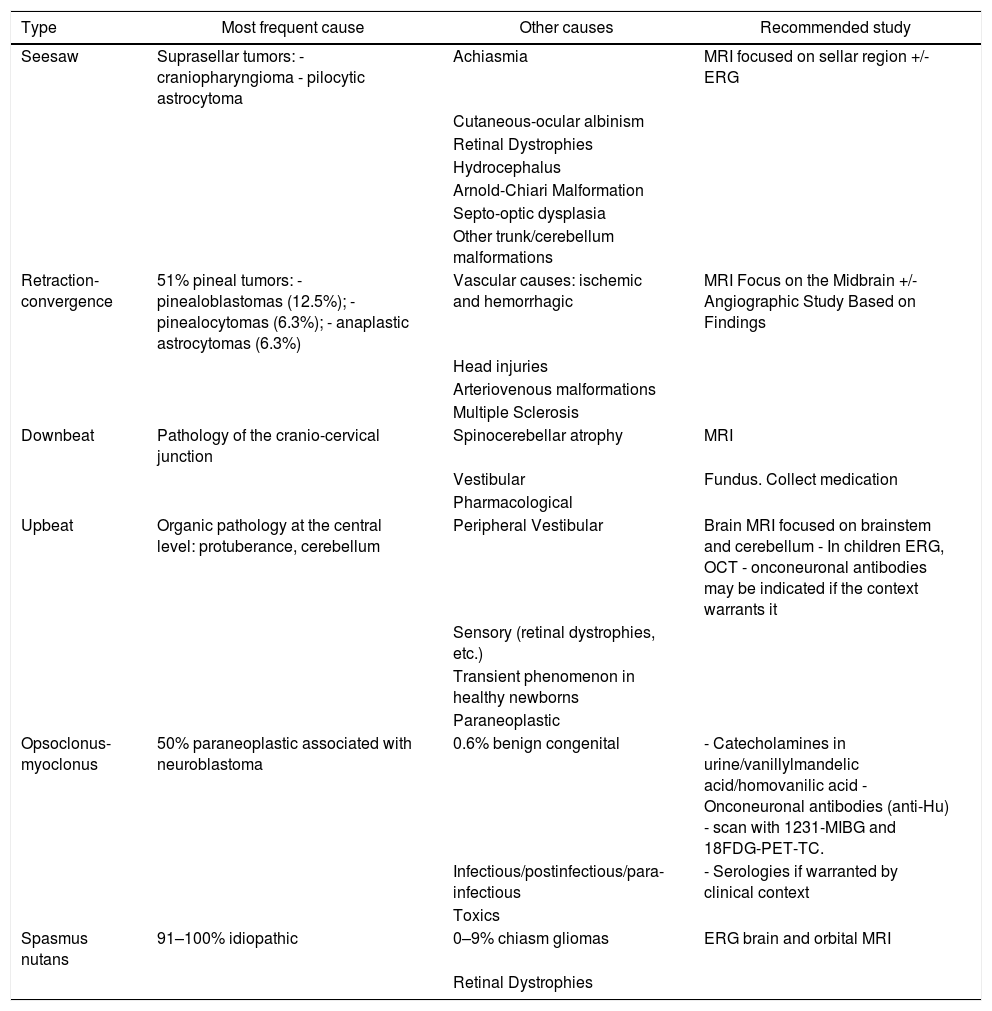Eye oscillations, both nystagmic and non-nystagic, can occur from birth. Most correspond to infantile nystagmus that dubates in the first six months of life, which include idiopathic, sensory, latent, or overt latent motor nystagmus. Those associated with neurological diseases or syndromes correspond to approximately 33%, their identification and correct evaluation being important given the potential visual and vital complications.
Material and methodsWe made a systematic review of the literature on supranuclear gaze control mechanisms and the main ocular oscillations with possible neurological implications, both in childhood. With this, we intend to assess if there are already established clinical-anatomical associations, and to propose a protocol on the complementary studies to be carried out in these cases.
ResultsThere are still anatomical pathways involved in supranuclear gaze control that are not fully clarified and understood. Besides, except in the case of nystagmus in seesaw and upbeat, we did not find anatomical explanations for their pathogenesis. The need for complete neuro-ophthalmological physical examinations and the request for additional tests in children who present ocular oscillations with neurological characteristics are clear.
ConclusionsSupranuclear gaze control follows a complex neurological network that still needs to be studied better. With a better dissection of the same we could try to understand why the ocular oscillations that we studied have these specific forms of presentation. As for the complementary requests, the request for neuroimaging tests is practically constant, making the others according to the specific case before which we find ourselves.
Las oscilaciones oculares, tanto nistágmicas como no nistágmicas, pueden ocurrir desde el nacimiento. La mayoría corresponden a nistagmus infantiles que dubatan en los seis primeros meses de vida, donde se incluyen el nistagmus motor idiopático, sensorial, latente o latente manifiesto. Aquellas asociadas con enfermedades o síndromes neurológicos corresponden aproximadamente al 33%, siendo importante su identificación y correcta valoración dadas las potenciales complicaciones tanto visuales como vitales.
Material y métodosHemos realizado una revisión sistemática de la literatura sobre los mecanismos de control supranuclear de la mirada y de las principales oscilaciones oculares con posibles implicaciones neurológicas, ambas en la edad infantil. Pretendemos con ello valorar si existen asociaciones clínico-anatómicas ya establecidas, y plantear un protocolo sobre los estudios complementarios a realizar en estos casos.
ResultadosExisten todavía vías anatómicas implicadas en el control supranuclear de la mirada que no están totalmente esclarecidas y entendidas. Además, salvo en el caso de los nistagmus en seesaw y en upbeat, no hemos encontrado explicaciones anatómicas sobre la patogénesis de los mismos. Si que queda clara la necesidad de realizar exploraciones físicas neuro-oftalmológicas completas y la petición de pruebas complementarias en los niños que presenten oscilaciones oculares con características neurológicas.
ConclusionesEl control supranuclear de la mirada sigue una compleja red neurológica que aún necesita ser estudiada en mayor prfundidad. Con una mejor disección de la misma podríamos inrtentar entender por qué las oscilaciones oculares que estudiamos tienen esas formas de presentación específicas. En cuanto a las peticiones complementarias, es prácticamente constante la solicitud de pruebas de neuroimágen, realizando las demás según el caso concreto ante el que nos econtremos.















